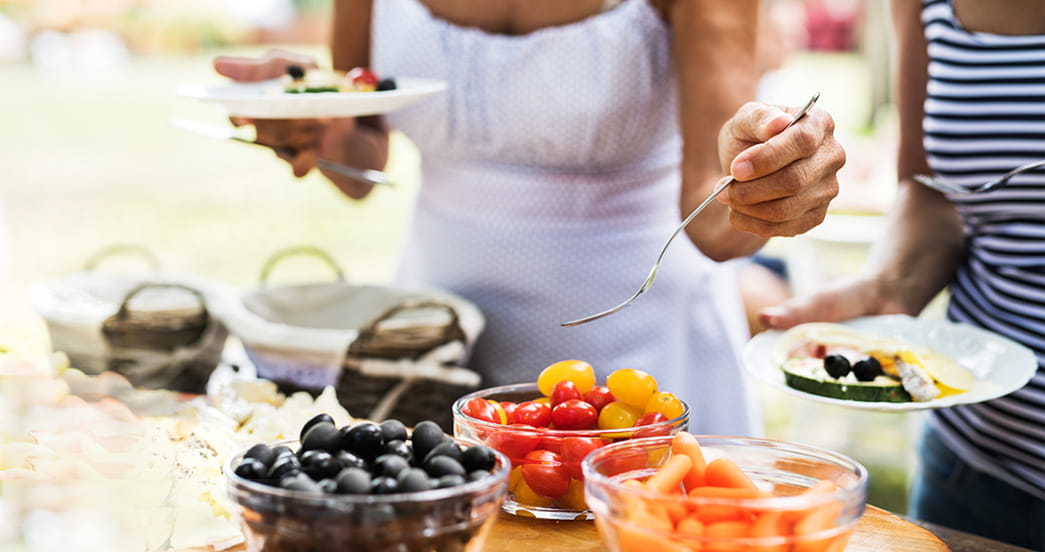Fresh, Frozen or Canned Fruit and Vegetables: All Can Be Healthy Choices

Fresh produce, canned and frozen fruits and vegetables can all help to meet the recommended 4½ cups of each daily.
Canned Fruits and Vegetables
Canned fruits and vegetables are convenient to have on hand. They usually have a long shelf life and are inexpensive.
- Check the sodium. Sodium is often added to canned vegetables and beans to preserve them. You can reduce the amount of sodium you consume by rinsing and draining the canned food before eating it. When grocery shopping, compare the sodium content on the Nutrition Facts label and choose the product with the lowest amount. Look for products with:
- Low sodium (<140 mg).
- Reduced sodium (25% less sodium than the regular canned produce).
- No salt added (<5mg).
- Check for added sugar. Choose fruit that’s canned in water, its own juice or in light syrup.
Here are some delicious ways to use canned fruits and vegetables:
- For a quick and filling vegetable soup, add drained and rinsed cans of no-salt-added or reduced-sodium corn, tomatoes and pinto beans or any other vegetable to fat-free, low-sodium chicken broth.
- To make a healthy bean dip, use a blender or food processor to process drained and rinsed beans, such as reduced-sodium or no-salt-added chickpeas or northern beans. (Or, you can use a fork to smash them in a bowl.) Add a small amount of olive oil, tahini, lemon juice and garlic powder for big flavor.
- For a healthy dessert, serve canned fruit topped with fat-free/low-fat, no-sugar-added yogurt.
- For breakfast, top whole-grain cereal with canned fruit.
Frozen Fruit and Vegetables
Frozen fruits and vegetables are picked at the peak of ripeness and then flash frozen to preserve optimal nutrition. They last for several months in the freezer and can be a very economical choice.
- Check the sodium. Compare the sodium content on the Nutrition Facts label and choose the product with the lowest amount. Vegetables frozen with added sauces and seasonings usually contain excess sodium and calories.
- Check for added sugar: Choose 100% fruits that have been frozen without added sugars.
Here are some delicious ways to use frozen vegetables and fruits:
- When boiling water for pasta, add frozen veggies at the end of the cooking time for added flavor, texture and nutrition.
- Blend frozen fruit with fat-fee/low-fat milk or fat-free/low-fat no-added-sugar yogurt.
- Gently fold frozen berries into baked goods and oatmeal.
Fresh Fruit and Vegetables
Fresh fruits and vegetables can be easy, portable choices. Take an apple, orange, banana, grapes or baby carrots when you’re on-the-go. These snacks will satisfy you and help to avoid snacks that are high in calories, saturated/trans fats, added sugar and sodium.
- Look for seasonal choices. Fresh fruit and vegetables grown locally or in your garden will have more flavor and nutrition than produce at the store that’s been picked weeks before, stored and shipped long distances. Locally grown foods also have a lower environmental impact. Seek out farmers markets for fresh, seasonal options, too.
Here are some delicious ways to use fresh fruit and vegetables:
- Add extra vegetables to sandwiches, such as shredded carrot, sliced summer squash and avocado.
- Serve raw veggies with hummus for a healthy snack.
- Serve a colorful fruit salad for dessert.
- Add pureed fruits and veggies to sauces, smoothies, soups and more for a boost of flavor and nutrients.







